Is your kitchen in need of a style and functionality upgrade? Look no further than a brand-new kitchen sink. With a wide array of shapes, sizes, colors, and materials to choose from, you’ll discover the perfect sink that complements both your style and budget.
In this comprehensive guide, we’ve curated a selection of kitchen sink ideas that promise to rejuvenate your kitchen space. From timeless stainless steel sinks to contemporary farmhouse designs, we’re here to help you find the ideal sink for your dream kitchen.
Types of Kitchen Sinks
Before embarking on your kitchen sink journey, it’s essential to acquaint yourself with the various types available in the market. Below, we delve into the most popular kitchen sink options:
Stainless Steel Kitchen Sinks: Durability Meets Versatility
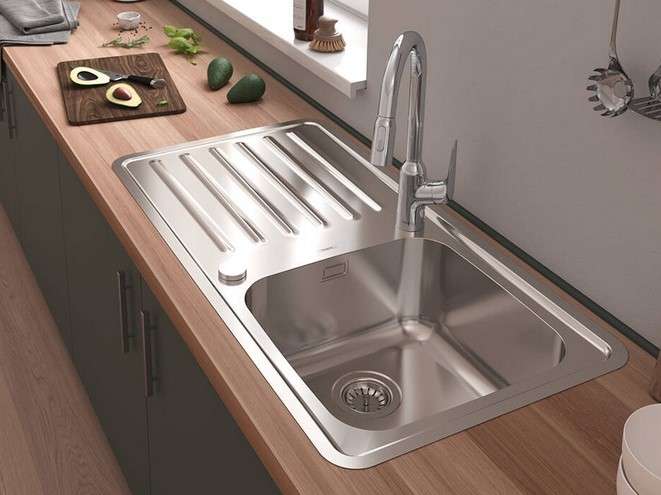
Stainless steel reigns supreme as a favored material for kitchen sinks. Its durability, ease of maintenance, and wide range of size and shape options make it an attractive choice.
Whether you’re on a budget or seeking a high-end designer sink, stainless steel has something to offer for everyone.
Porcelain Kitchen Sinks: Elegance and Easy Upkeep
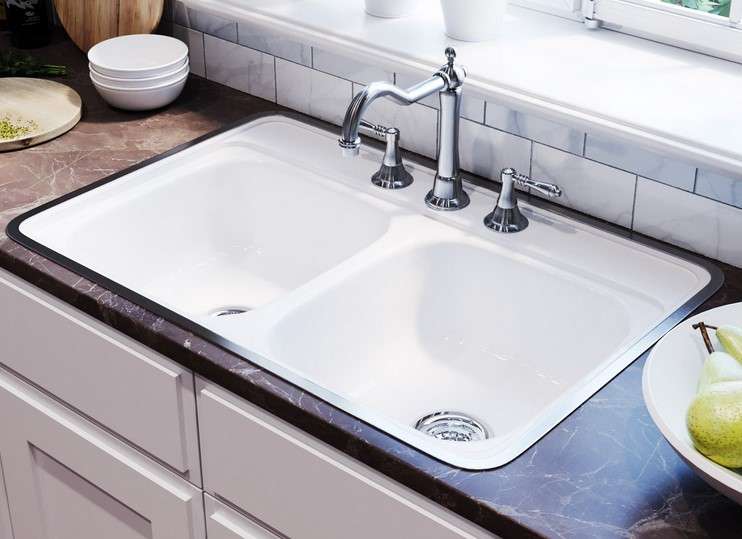
Porcelain kitchen sinks exude timeless beauty and are a breeze to maintain. With an extensive palette of colors and styles, you’ll effortlessly find one that harmonizes with your kitchen decor.
What’s more, porcelain sinks are resistant to stains and scratches, ensuring longevity.
Granite Kitchen Sinks: Rugged Elegance
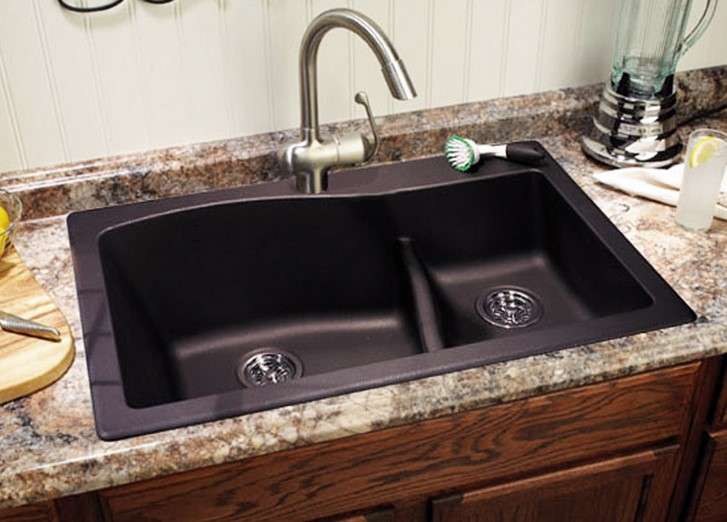
Granite kitchen sinks have earned their place in many households for good reason. Not only are they exceptionally durable, but they also resist heat and come in a variety of captivating colors and patterns.
Cleaning and maintenance are a breeze with granite sinks.
Copper Kitchen Sinks: A Touch of Opulence
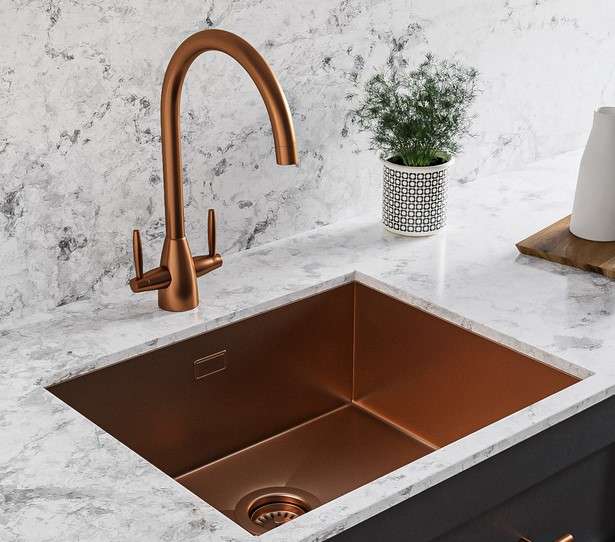
For a touch of luxury, consider copper kitchen sinks. These sinks are available in a range of styles, from classic to modern, and boast heat resistance and easy cleaning. They’re sure to be a conversation piece in your kitchen.
Fireclay Kitchen Sinks: Timeless Charm
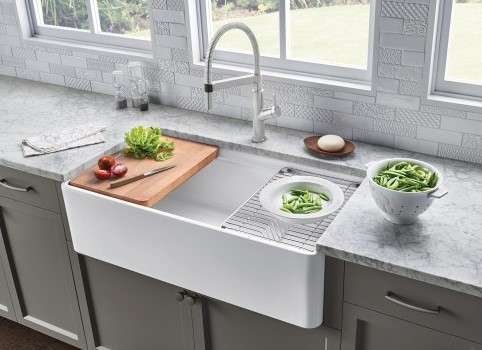
If you desire a classic, enduring aesthetic, look no further than fireclay kitchen sinks. Known for their exceptional durability and an array of colors, these sinks also hold up well against heat and scratches. Fireclay sinks exude timeless charm.
Cast Iron Kitchen Sinks: Rustic Appeal
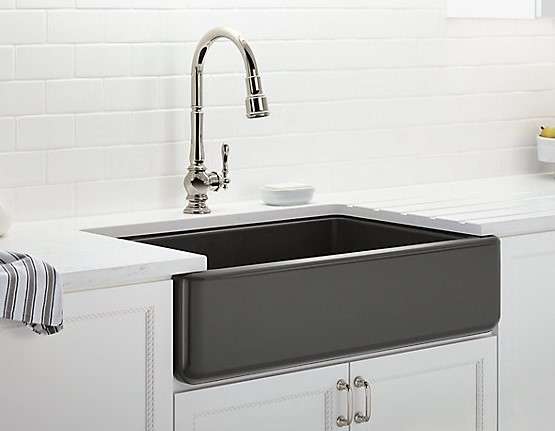
For those seeking a rustic, farmhouse-style ambiance, cast iron kitchen sinks are a perfect match. These heavy-duty sinks are available in various colors, offering easy cleaning and maintenance while adding character to your kitchen.
Unearth the Best Kitchen Sink Ideas
With your knowledge of different sink types, let’s explore some of the best kitchen sink ideas to help you find the perfect match for your culinary haven.
Undermount Kitchen Sinks: Modern Elegance
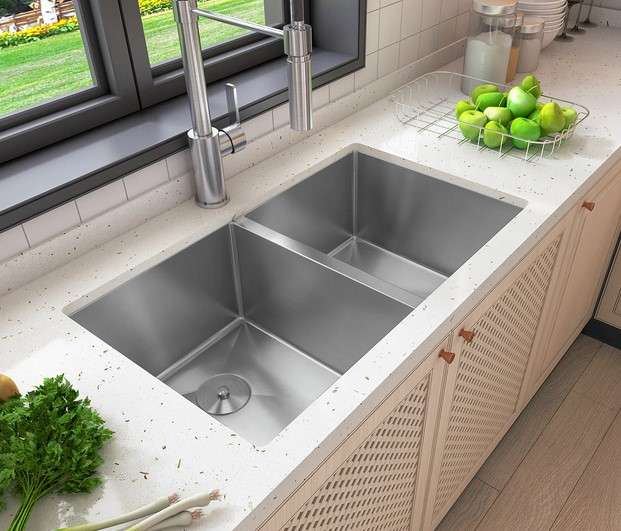
Undermount kitchen sinks are a fantastic choice for those aiming for a sleek, modern appearance. Installed beneath the countertop, they create a streamlined, minimalist look. Cleaning and maintenance are a breeze with undermount sinks.
Double Bowl Kitchen Sinks: Versatile Workstations
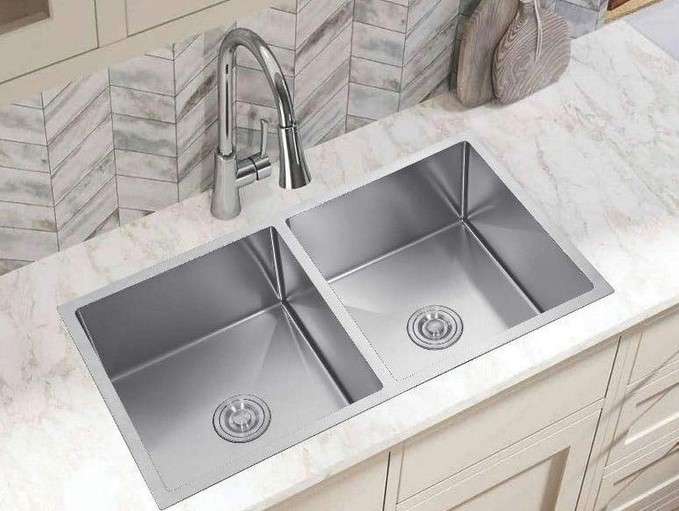
Double bowl kitchen sinks are among the most sought-after options. They provide ample space for dishwashing and food prep. Available in various materials, from stainless steel to porcelain, these sinks offer both practicality and style.
Farmhouse Kitchen Sinks: Classic, Rustic Charm
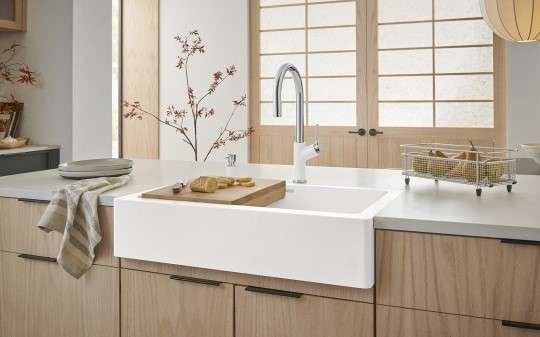
Farmhouse kitchen sinks, often crafted from cast iron or fireclay, embody classic, rustic elegance. They come in a spectrum of colors, ensuring a seamless fit with your kitchen decor. With easy maintenance, farmhouse sinks elevate your kitchen’s appeal.
Modern Kitchen Sinks: Contemporary Flair
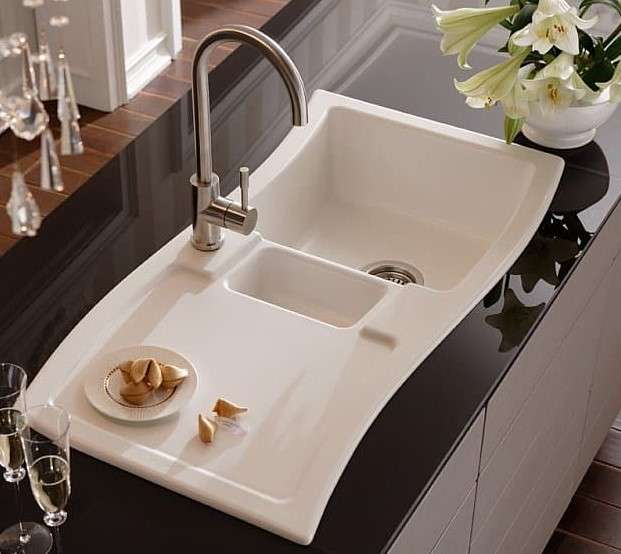
If you’re aiming for a more contemporary look, modern kitchen sinks are the way to go. Typically made of stainless steel or granite, they come in diverse shapes and sizes, allowing you to align them with your kitchen’s aesthetic. Cleaning and maintenance are hassle-free.
Bar Sinks: Compact Efficiency
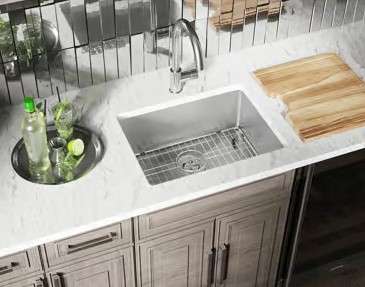
Perfect for supplementary dishwashing and food prep, bar sinks are typically smaller than standard kitchen sinks. They’re available in various materials, such as stainless steel and porcelain, ensuring functionality while conserving space. Cleaning and maintenance are a breeze with these compact sinks.
Conclusion:
In the realm of kitchen sink ideas, the options are abundant. From the classic appeal of stainless steel to the rustic charm of farmhouse sinks and the modern elegance of contemporary designs, you’re certain to find a kitchen sink that aligns with your style and budget.
Regardless of the sink you choose, its transformational effect on your kitchen is undeniable. Don’t hesitate to explore the diverse world of kitchen sinks to discover the perfect one that will turn your kitchen into a dream come true, both in terms of appearance and functionality.
Related Posts:-
Drawer kitchen organization ideas
What are the best materials for a kitchen sink?
Selecting the ideal materials for your kitchen sink is a pivotal decision, as it not only affects the sink’s aesthetics but also its functionality and durability. To create the perfect culinary workspace, consider these top-notch materials:
- Stainless Steel: A perennial favorite, stainless steel sinks blend seamlessly with various kitchen designs. They are resistant to stains, corrosion, and heat, making them an excellent choice for busy kitchens. Opt for a thicker gauge for enhanced durability and noise reduction.
- Granite Composite: If you desire both durability and aesthetics, granite composite sinks are a top pick. Crafted from a blend of granite stone and acrylic resins, they offer remarkable resistance to scratches, heat, and stains. Plus, they come in a spectrum of colors to suit your kitchen’s theme.
- Cast Iron: Known for their timeless charm and durability, cast iron sinks are enamelled with porcelain, providing a glossy finish that’s easy to clean. These sinks are heavy, so ensure your countertop can support their weight. They are, however, prone to chipping if heavy objects are dropped into them.
- Fireclay: Fireclay sinks are ceramic sinks that are fired at extremely high temperatures, resulting in a durable and glossy finish. They are resistant to staining and scratching and bring a classic farmhouse feel to your kitchen. Maintenance is straightforward, requiring only routine cleaning.
- Copper: For a truly unique and rustic appearance, copper sinks are a standout choice. They develop a stunning patina over time, adding character to your kitchen. Copper has natural antimicrobial properties, making it a hygienic option. However, it does require periodic polishing to maintain its luster.
- Quartz: Quartz sinks are engineered to offer the beauty of natural stone with enhanced durability. They are scratch and stain-resistant, making them ideal for high-traffic kitchens. These sinks are available in various colors and patterns to match your decor.
- Acrylic: Affordable and lightweight, acrylic sinks are a budget-friendly choice. They come in a variety of colors and are easy to install. However, they are less durable than other options and can be vulnerable to scratches and discoloration over time.
- Natural Stone: If you want a luxurious and unique sink, consider natural stone options like marble or onyx. These sinks are handcrafted and can be customized to your specifications. They require proper sealing and maintenance to prevent staining and damage.
- Glass: For a modern and eye-catching look, glass sinks are an intriguing choice. They are available in various colors and styles, adding a touch of elegance to your kitchen. However, they can be more susceptible to scratches and chips, so handle with care.
In conclusion, the best material for your kitchen sink ultimately depends on your preferences, budget, and the level of maintenance you’re willing to undertake. Consider the aesthetics, durability, and functionality to find the perfect match that complements your kitchen’s style and meets your daily needs.
How do I choose the right size sink for my kitchen?
Selecting the perfect size sink for your kitchen is a crucial decision, as it directly impacts both the functionality and aesthetics of your culinary space. To ensure you make the right choice, follow these comprehensive guidelines:
Assess Your Kitchen Layout:
Begin by examining your kitchen’s layout, including the available space for the sink. Take note of any constraints, such as cabinet size or existing plumbing, which might limit your options.
Consider Your Cooking Habits:
Think about how you use your kitchen on a daily basis. Do you frequently cook elaborate meals for a large family or entertain guests? Or is your kitchen primarily used for light meal preparation? Your cooking habits will influence the size of the sink you need.
Size of Cookware and Utensils:
Take stock of your cookware and utensils. If you have large pots, pans, or baking sheets, opt for a deeper and wider sink to accommodate these items comfortably. A deep sink also helps in preventing splashes.
Think About Cleanup Style:
Consider your approach to cleaning up. If you prefer to wash dishes by hand rather than relying on a dishwasher, a larger sink with ample basin space will make the task more convenient.
Cabinet Size Matters:
Ensure your sink choice aligns with the size of the cabinet beneath it. Measure the cabinet’s width and depth to confirm it can accommodate your desired sink size. Keep in mind that the sink may require some additional space for mounting.
Single or Double Basin:
Decide whether you want a single or double basin sink. Single basin sinks provide a larger, uninterrupted space for washing large items but may lack the separation for multitasking. Double basin sinks offer versatility but may have smaller compartments.
Sink Depth:
Sink depth can vary significantly. Shallower sinks are easier to reach into but may not accommodate large items. Deeper sinks are great for large items but may require bending over more when working at the countertop.
Consider the Countertop:
Ensure your chosen sink complements your countertop material and style. The sink should integrate seamlessly with the countertop for a cohesive look.
Faucet Compatibility:
Verify that the sink size allows for proper faucet installation and functionality. The faucet should comfortably reach all areas of the sink, including both basins if applicable.
Personal Preference:
Ultimately, your personal preferences matter. Some individuals prefer a spacious sink for versatility, while others may prioritize counter space and opt for a smaller sink.
Budget and Maintenance:
Keep your budget in mind when choosing the size of your sink. Larger sinks often come with higher price tags due to the increased material and manufacturing costs. Additionally, consider the maintenance requirements of larger sinks, as they may require more effort to keep clean.
Visual Harmony:
Lastly, think about the overall aesthetics of your kitchen. The sink should complement the style and design of the kitchen, creating a harmonious and visually appealing space.
By taking these factors into account, you can confidently choose the right size sink for your kitchen that not only meets your practical needs but also enhances the overall look and feel of the space.
Are undermount sinks better than top-mount sinks?
When it comes to the eternal debate between undermount and top-mount sinks, there are distinct advantages to consider, each catering to different preferences and kitchen styles.
Undermount sinks, with their sleek and seamless installation beneath the countertop, offer a modern and visually appealing aesthetic. This design choice not only enhances the overall look of your kitchen but also simplifies countertop maintenance, as there are no rims or edges to trap debris, making cleaning a breeze.
Furthermore, undermount sinks maximize usable counter space, which can be a crucial consideration in smaller kitchens.
On the other hand, top-mount sinks, also known as drop-in sinks, have their own set of benefits. They are generally easier and less expensive to install, making them a practical choice for budget-conscious homeowners.
Additionally, top-mount sinks have a lip that rests on the countertop, which can help prevent water from spilling over the edge and potentially damaging your cabinets or floor.
The choice between undermount and top-mount sinks ultimately boils down to your personal preferences and the specific needs of your kitchen. If you prioritize a clean, contemporary look and are willing to invest a bit more in installation, undermount sinks may be your ideal choice.
However, if you seek a more budget-friendly option that is easier to install and offers some spill containment, top-mount sinks could be the way to go.
In conclusion, neither option is inherently better than the other; it’s all about what suits your style, budget, and functional requirements. So, take your time to consider these factors and make the choice that aligns best with your kitchen vision.
What are the pros and cons of farmhouse sinks?
Farmhouse sinks, also known as apron-front sinks, have gained popularity in modern kitchen design. They offer a charming and rustic aesthetic that can enhance the overall look and functionality of your kitchen. However, like any design choice, they come with their own set of pros and cons.
Pros:
- Aesthetic Appeal: Farmhouse sinks instantly add a touch of timeless elegance to your kitchen. Their unique design and exposed front create a visually appealing focal point, making them a popular choice for those seeking a rustic or country-style kitchen.
- Spaciousness: These sinks are typically deeper and wider than traditional undermount or drop-in sinks, providing ample space for washing large pots, pans, and even small appliances. This makes them highly practical for households with heavy cooking demands.
- Durability: Farmhouse sinks are often made from durable materials such as fireclay or cast iron, which are resistant to chips, cracks, and scratches. They can withstand the rigors of daily use and retain their appearance over time.
- Ergonomics: The front-facing design of farmhouse sinks allows for more comfortable access to the sink area, reducing strain on your back and shoulders when washing dishes or prepping food.
- Versatility: These sinks are available in various materials, colors, and styles, allowing you to choose one that complements your kitchen’s design and meets your functional needs.
Cons:
- Installation Complexity: Installing a farmhouse sink can be more complicated than traditional sinks. They require custom cabinetry and countertop modifications to accommodate their unique design, which can increase installation costs.
- Limited Counter Space: Because farmhouse sinks extend beyond the countertop, they can reduce available counter space. This may be a drawback for those with limited kitchen workspace.
- Water Splashing: The exposed front of a farmhouse sink can lead to water splashing onto the floor or cabinets more easily, requiring you to be mindful of how you use the sink to avoid messes.
- Maintenance: Some materials, like fireclay, may require more maintenance to prevent staining and maintain their appearance. Harsh abrasive cleaners should be avoided.
- Cost: Farmhouse sinks, especially those made from premium materials, can be more expensive than standard sinks due to their unique design and construction.
In summary, farmhouse sinks bring a charming aesthetic and practical benefits to your kitchen but require careful consideration of installation, maintenance, and their impact on counter space. Ultimately, the decision to install one should align with your design preferences and how you use your kitchen on a daily basis.
Can I install a kitchen sink without professional help?
Installing a kitchen sink without professional help is indeed possible, and many homeowners choose to tackle this task themselves to save money and gain a sense of accomplishment.
However, it’s important to be aware that this project can vary in complexity depending on your specific circumstances and skill level.
Here are the general steps to guide you through the process:
- Gather Your Tools and Materials: Before you begin, ensure you have all the necessary tools and materials on hand. This typically includes a sink and faucet, a drain assembly, plumber’s tape, a wrench, screwdrivers, a hacksaw, a pipe cutter, and silicone caulk.
- Measure and Plan: Measure the existing sink opening and the new sink to ensure a proper fit. Plan the layout of the plumbing and consider any adjustments needed to accommodate the new sink.
- Shut Off Water: Turn off the water supply to the kitchen, typically under the sink. Disconnect any existing plumbing connections, including the hot and cold water lines and the drain pipe.
- Remove the Old Sink: Carefully remove the old sink and faucet. Be cautious with the existing plumbing connections.
- Install the New Sink: Place the new sink into the opening and secure it in place according to the manufacturer’s instructions. This usually involves using clips or brackets provided with the sink.
- Connect the Drain Assembly: Assemble the drain components according to the manufacturer’s instructions. Make sure to use plumber’s tape on threaded connections to prevent leaks.
- Connect the Water Lines: Reconnect the hot and cold water lines to the faucet. Ensure that the connections are tight and secure.
- Check for Leaks: Turn the water supply back on and check for any leaks around the drain and water connections. Tighten any loose fittings as needed.
- Seal the Edges: Apply a bead of silicone caulk around the edges of the sink where it meets the countertop. This helps to create a watertight seal and provides a finished look.
- Test Your Work: Run water in the sink and check for any leaks. Ensure that the drain is functioning properly.
Remember that while installing a kitchen sink can be a DIY project, it may become more challenging if you encounter unexpected issues with your plumbing or if you lack experience in this area. If you’re unsure about any aspect of the installation, it’s always a good idea to consult with a professional plumber to ensure everything is done correctly and safely.
